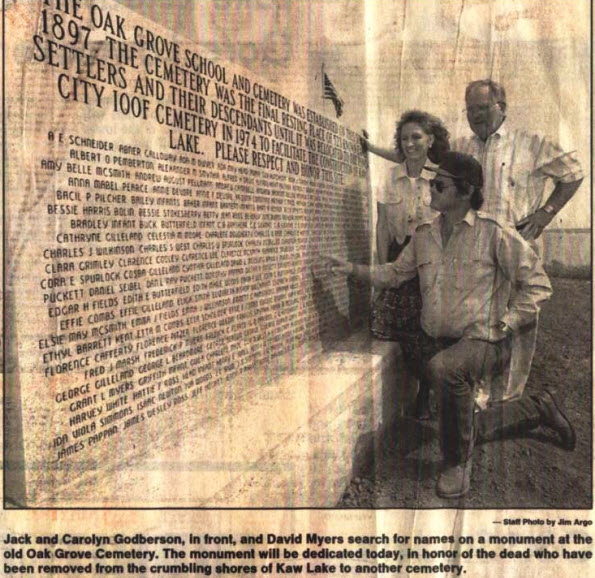


 |
 |  |
The New Monument © Daily Oklahoman 05-23-1998 Submitted by: Carolyn Godberson

|
New Monument To Honor Dead From Cemetery
By Ann DeFrange
Staff Writer
Kaw City – Myers and McClung, Lee and Walker and Ross. The names represent families that settled in Oklahoma and died here and were buried where their relatives thought they would rest forever. Today, they will be buried again.
The remains of 23 people from a cemetery that washed into Kaw Lake will be memorialized in Ponca City today. At 3 PM, a monument will be dedicated to them at the Oak Grove site on Coon Creek.
Many of them were the adventuresome settlers who made the land run of 1893, or their descendents, who lived on the same land their great – great – grandfathers homesteaded in the last century. In the Cherokee Strip region of Oklahoma, the responsibilities of family members and family land are not taken lightly.
John and Caroline Binnsac were German immigrants who homesteaded 160 acres at what is now Coon Creek Cove on the lake. Their children were born there, and when the first neighbor died there, John donated land to bury her. By 1897, he had turned over 5 acres of his homestead for a cemetery and a school.
His wife was married there, then himself, then various descendants. In 1972, construction began on Kaw Lake, an effort by the U. S. Army Corps of Engineers to control a floodplain of the Arkansas River. But in Oklahoma, the man-made lakes sit on top of the existing civilization, and people, towns and cemeteries had to be relocated.
Some locals still express the opinion that the matter was not handled with the best possible sensitivity, but nevertheless the Corps provided some assistance to remove homes and other buildings to a new town site at a higher level. It hired a firm from North Carolina to remove all the headstones and caskets from Oak Grove Cemetery to a section of the I00F Cemetery in Ponca City. The contents of Washunga Cemetery, the final resting place for many Kaws, were to be moved to Newkirk.
Jack Godberson said many family members came in 1972 to oversee the removal of their family graves, but some were unable to be there. It's evident now they should have been.
The Corps flooded the area, and over the years, the water slowly disintegrated the sandy banks and lapped closer and closer to the edge of the former Cemetery. Soon it became obvious that the removal company hadn't done its job.
The descendants continued to visit the site of the original Cemetery. Orrin Ross said he often walked through the grounds "for sentimental reasons."
One day, he saw something "pretty upsetting." A skeletal foot was sticking out of the bank.
By 1987, visitors to the Cemetery site began to notice caskets sticking out of the soil, exposed by constant waves. The caskets were deteriorating. Some bones were evident.
The families had been under the impression the bodies were all removed.
The Corps stored the remains of 18 people in a Ponca City Cemetery and listed them as "unknown."
John Binsack's great – granddaughter, Carolyn Godberson, went to negotiate with the Corps. David Myers of Ponca City, whose relatives rested for a while at Oak Grove, went with her. Generally, they said, understanding from the Corps was lacking. Some used stronger language.
"There were piles of bones out here," Carolyn Godberson said. "The government told us they moved them. And you want to trust the government."
It was a bitter blow for the people who had already lost their homestead land to the water, Myers said.
The solution came from an unexpected source. Across the lake from Oak Grove Cemetery, the Washunga Cemetery of the Kaw Nation was suffering from the same erosion and the same surprise of caskets left in the ground. Full skeletons were found on the ground there. But the Kaws had the power of recent legislation that protects American Indian burial sites, human remains and funerary items. Joining with the Kaw descendants gave the descendants of the white settlers some clout.
Some of the remains were identified by government forensic specialists. People remembered as amputees or with certain bone formations or of Indian origins can be named.
But all of them were aunts and uncles and grandparents and siblings who were being exposed from their burial grounds.
The Corps had agreed to remove all the bodies exposed now, and to keep a careful eye on further erosion. There is riprap along the shoreline now, placed there by the Corps. The Corps bought the monument that will be dedicated, and the names of 523 people who were buried there are engraved on it. The names were available because the cemetery records were still in Carolyn Godberson's possession.
The 2 – ton granite monument has post support and is set against the wind coming off the lake so it will never erode.
Carolyn Godberson's son, Mark, is 21 and still in the area his great – great – grandfather settled. He will watch over the sacred ground when it's his turn, he said.
Or else, "the next generation down won't know there was a cemetery here."
|Oak Grove Cemetery Page| |Kay County Cemetery Page| |Home|
This site may be freely linked, but not duplicated in any way without consent.
All rights reserved! Commercial use of material within this site is prohibited!
© 2000-2024 Oklahoma CemeteriesThe information on this site is provided free for the purpose of researching your genealogy. This material may be freely used by non-commercial entities, for your own research, as long as this message remains on all copied material. The information contained in this site may not be copied to any other site without written "snail-mail" permission. If you wish to have a copy of a donor's material, you must have their permission. All information found on these pages is under copyright of Oklahoma Cemeteries. This is to protect any and all information donated. The original submitter or source of the information will retain their copyright. Unless otherwise stated, any donated material is given to Oklahoma Cemeteries to make it available online. This material will always be available at no cost, it will always remain free to the researcher.